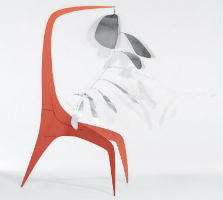
NEW YORK – “Calder: Hypermobility,” currently on view at the Whitney Museum of American Art, focuses on the extraordinary breadth of movement and sound in the work of Alexander Calder. This exhibition brings together a rich constellation of key sculptures and provides a rare opportunity to experience the works as the artist intended—in motion.
Regular activations will occur in the galleries, revealing the inherent kinetic nature of Calder’s work, as well as its relationship to performance. Influenced in part by the artist’s fascination and engagement with choreography, Calder’s sculptures contain an embedded performativity that is reflected in their idiosyncratic motions and the perceptual responses they provoke.
In the early 1930s, Calder invented an entirely new mode of art, the mobile—a kinetic form of sculpture in which carefully balanced components manifest their own unique systems of movement. These works operate in highly sophisticated ways, ranging from gentle rotations to uncanny gestures, and at times, trigger unpredictable percussive sounds. “Calder: Hypermobility” encompasses major examples of Calder’s work including early motor-driven abstractions, sound-generating gongs, and standing and hanging mobiles.
In collaboration with the Calder Foundation, the exhibition will feature an expansive series of performances and events, including a number of episodic, one-time demonstrations of rarely seen works, as well as new commissions, which will bring contemporary artists into dialogue with Calder’s innovations and illuminate the many ways in which his art continues to challenge and inform new generations.
Musician Jim O’Rourke has created an original composition to accompany the exhibition designed to be experienced as a sound walk for the show. Elements of jazz, modern composition, and field recordings interact as gradually reappearing musical components, forming a complex internal structure through their own motions.
The exhibition will be on view through Oct. 23.



